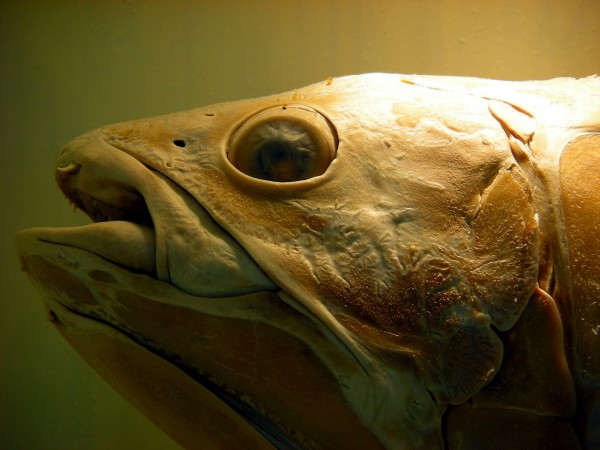在马达加斯加重新发现了四足“活化石”鱼
Coelacanths, an extinct fossil that dates back to roughly 420 million years ago, was unexpectedly rediscovered in the tropical island-country of Madagascar in East Africa.
腔棘鱼是一种大约4.2亿年前灭绝的四足“活化石”鱼,近日在东非热带岛国——马达加斯加被意外地重新发现。
According to reports from Mongabay News, a nonprofit environmental conservation group coelacanths, the four-legged fossil fish has just been found alive and kicking in the West Indian Ocean just off the coast of Madagascar.
据Mongabay News的报道,非营利性环境保护组织发现这条腔棘鱼,是在在马达加斯加海岸附近的西印度洋,当时这条鱼还活着,还在踢着脚。

(Photo: Pascalou petit / WikiCommons)
Coelacanths or Latimeria are carnivorous fish that live up to 60 years and grow as large as 6.5 feet and weigh approximately 198 pounds.
腔棘鱼或乳香鱼是肉食性鱼类,寿命长达60年,长到6.5英尺,重约198磅。
According to National Geographic, these primitive-looking coelacanths are believed to have gone extinct 65 million years ago along with the dinosaurs. However, in 1938, sa South African museum curator ignited a scientific debate on how the unique lobe-finned fish fits into the existing evolutionary timeline of land animals.
据《国家地理》报道,这些长相原始的腔棘鱼被认为在6500万年前随着恐龙一起灭绝了。然而,在1938年,一位南非博物馆馆长引发了一场科学辩论,
Coelacanths are rarely sighted deep-sea creatures that thrived in depths of up to 2,300 feet below the surface.
腔棘鱼是一种罕见的深海生物,它们在地表以下2300英尺深处繁衍生息。
The uniqueness of the "four-legged living fossil" is its paired lobe fins extending away from its body like human legs alternating pattern similar to a trotting horse.
这种“四足活化石”的独特之处在于它的双叶鳍从身体延伸出来,就像人类的腿交替出现,就像一匹小跑的马。
The unexpected rediscovery of the "living fossils" was thanks to the shark hunters using gillnets during their expedition. As the hunters targeted sharks for their oil, fins, and various other commercial enterprises, their devices were able to reach deep-sea nets where coelacanths gathered roughly 328-492 feet below the surface.
这些“活化石”的意外重新发现要归功于探险期间用刺网捕鲨的猎人们。当猎人以鲨鱼为目标寻找它们的鱼油、鱼鳍和其他各种商业企业时,他们的设备就能够到达深海网,在那里腔棘鱼大约聚集在水面以下328-492英尺的地方。
A recent study published in the journal SA Journal of Science, entitled "Coelacanth discoveries in Madagascar, with recommendations on research and conservation" warns that the "four-legged fossils" may face new species-level threats to their survival due to the uptick in shark hunting that boomed in the 1980s.
《科学杂志》(SA journal of Science)最近发表的一项题为“马达加斯加腔棘鱼的发现,以及对研究和保护的建议”的研究警告说,由于20世纪80年代兴起的捕猎鲨鱼的热潮,这些“四足化石”可能面临新物种级别的生存威胁。
The authors of the study wrote that jarifa gillnets that are used to catch sharks are relatively new and believed to be a more deadly innovation because they are large and can be set in deep water.
这项研究的作者写道,用于捕捉鲨鱼的jarifa刺网相对较新,被认为是一种更致命的创新,因为它们很大,可以在深水中使用。
Researchers fear that the rediscovery of the coelacanths may lead to heightened risks of "exploitation" especially in Madagascar where past sightings have been cited. The team wrote that there is no doubt that the sizeable mesh jarifa gillnets is, as of today, the biggest threat to the coelacanth's survival in Madagascar.
研究人员担心,腔棘鱼的重新发现可能会导致更高的“开发”风险,特别是在马达加斯加,那里曾经有人提到过这种现象。研究小组写道,毫无疑问,到今天为止,相当大的网眼刺网是对马达加斯加腔棘鱼生存的最大威胁。
The study goes on further purporting that Madagascar is more than likely to be the "epicenter" of many coelacanth subspecies which is why it is vital that local and international conservation steps be taken to preserve the extraordinary species that has predated the dinosaurs.
这项研究进一步指出,马达加斯加很可能是许多腔棘鱼亚种的“中心”,这就是为什么必须采取当地和国际保护措施来保护这些比恐龙还要早的特殊物种。
- 频道推荐
- |
- 全站推荐
- 推荐下载
- 网站推荐


















